Study on the Diffusion Law of Grouting Slurry at the Pile Tip of Bored Piles in Gravel Pebble Layers
Abstract
:1. Introduction
2. Model Establishment
2.1. The Slurry Diffusion Model Based on the Continuity Equation of Seepage
2.2. Model Establishment Process
3. Numerical Simulation
3.1. Slurry Diffusion Pattern Analysis
3.2. The Influence of Grouting Pressure
3.3. The Influence of the Porosity of the Gravel Layer at the Pile Tip
3.4. The Influence of the Slurry Diffusion Coefficient and Its Anisotropy
4. Conclusions
- (1)
- The diffusion process of the grouting slurry at the pile tip in the soil is regarded as the seepage process of water in the soil. By comparing the continuity equation of seepage and the continuity equation of substance diffusion, an equivalent relationship between the two is established. A 3D numerical model for slurry diffusion is established using the Diluted Species Transport Module for porous media in Comsol Multiphysics, and the contour cloud map of the slurry diffusion trend is obtained;
- (2)
- In the early stage of grouting, since the diffusion of the slurry is not sufficient, the impact of various influencing factors on the slurry diffusion radius is relatively small. As the grouting time extends, the impact of these factors on the slurry diffusion radius becomes increasingly significant;
- (3)
- With the continuation of grouting, the increase in pile-end porosity, grouting pressure, and slurry diffusion coefficient, or the decrease in the ratio of vertical to horizontal slurry diffusion coefficients, leads to an expansion of the slurry diffusion range. Among these, the pile-end porosity has the least impact on the slurry diffusion range, while the slurry diffusion coefficient has the greatest impact. To facilitate construction and ensure quality, the water–cement ratio should be between 0.5 and 0.7;
- (4)
- In practical engineering, the rebound height can be controlled, and the quality of grouting and reinforcement effect can be improved by adjusting the grouting pressure and changing the water–cement ratio of the slurry.
Author Contributions
Funding
Institutional Review Board Statement
Informed Consent Statement
Data Availability Statement
Acknowledgments
Conflicts of Interest
References
- Shi, P. Special Technical Problems in Deep Foundation Engineering; China Communications Press: Beijing, China, 2004; pp. 35–48. [Google Scholar]
- Sun, B.T.; Ling, X.Z.; Ling, C.; Zhu, G.R. Numerical simulation for diffusion and pressure distribution of permeation grouting. J. Hydraul. Eng. 2007, 38, 1402–1407. [Google Scholar]
- Bezuijen, A.; Talmon, A.; Kaalberg, F.; Plugge, R. Field measurements of grout pressures during tunneling of the Sophia rail tunnel. Soils Found. 2004, 44, 39–48. [Google Scholar] [CrossRef]
- Talmon, A.M.; Huisman, M. Fall velocity of particles in shear flow of drilling fluids. Tunn. Undergr. Space Technol. Inc. Trenchless Technol. Res. 2005, 20, 193–201. [Google Scholar] [CrossRef]
- Ding, W.; Duan, C.; Zhu, Y.; Zhao, T.; Huang, D.; Li, P. The behaviour of synchronous grouting in a quasi-rectangular shield tunnel based on a large visualized model test. Tunn. Undergr. Space Technol. 2019, 83, 409–424. [Google Scholar] [CrossRef]
- Yang, X.Z.; Wang, X.H.; Lei, J.S. Study on grouting diffusion radius of Bingham fluids. J. Hydraul. Eng. 2004, 6, 75–79. [Google Scholar]
- Liu, J.; Liu, R.T.; Zhang, X.; Li, S.C. Diffusion law model test and numerical simulation of cement fracture grouting. Chin. J. Rock Mech. Eng. 2012, 31, 2445–2452. [Google Scholar]
- He, J.; Chao, S. Diffusion simulation and calculation of post-grouted bored piles. Struct. Eng. 2013, 29, 136–140. [Google Scholar]
- Lin, Y.; Han, L. Numerical simulation of grouting diffusion and loosening ring reinforcement in soft rock roadway. Coal Technol. 2020, 39, 16–19. [Google Scholar]
- Huang, Y.; Wang, L.; Lu, Y. Study on the law of slurry diffusion within roadway surrounding rock during the whole section bolt-grouting process. J. Min. Saf. Eng. 2015, 32, 240–246. [Google Scholar]
- Huang, Y. Seepage and Diffusion Mechanisms of Blot-Grouting Slurry within Fractured Surrounding Rocks of Deep Roadway; China University of Mining and Technology: Beijing, China, 2015. [Google Scholar]
- Zhang, J.; Xu, Y.; Wu, D.; Liu, C.; Cheng, G.; Gao, Q.; Ren, Z.; Guo, C. Study on the Diffusion Parameters of Newtonian Fluid in High-Pressure Jet Disturbance Grouting. Buildings 2024, 14, 1491. [Google Scholar] [CrossRef]
- Qian, Z.; Jiang, Z.; Cao, L. Research and application of penetration radius calculation method for permeation grouting. Ind. Constr. 2012, 42, 100–104. [Google Scholar] [CrossRef]
- Khoshzaher, E.; Khodaei, S.; Chakeri, H. Laboratory investigation of the effect of sodium silicate and bentonite on the mechanical properties of the grout behind the segment in mechanized excavation. Rud.-Geološko-Naft. Zb. 2024, 39, 63–74. [Google Scholar] [CrossRef]
- Viviescas, J.C. Probabilistic Analyses of a Post-Grouted Anchor–Soil Bond Friction Performance Considering the Geological Origin and the SPT-N Tendency with Depth. Int. J. Geomech. 2023, 23, 06022038. [Google Scholar] [CrossRef]
- Useche-Infante, D.J.; Aiassa-Martinez, G.M.; Arrua, P.A.; Eberhardt, M. Performance evaluation of post-grouted drilled shafts: A review. Innov. Infrastruct. Solut. 2022, 7, 1–23. [Google Scholar] [CrossRef]
- Mavoungou, D.N.; Zhang, P.; Zhang, S.; Wang, Q. Numerical Simulation Research on Response Characteristics of Grouting Defects of Ground Penetrating Radar for Detection of Grouting Quality behind Tunnel Wall. J. World Archit. 2021, 5, 1–20. [Google Scholar] [CrossRef]
- Barbosa, M.G.T.; de Assis, A.P.; da Cunha, R.P. An Innovative Post Grouting Technique for Soil Nails. Geotech. Geol. Eng. 2022, 40, 5539–5546. [Google Scholar] [CrossRef]
- Nabizadeh, C.J. The performance of grouted and un-grouted helical piles in sand. Int. J. Geotech. Eng. 2019, 13, 516–524. [Google Scholar] [CrossRef]
- Zhong, Z.; Li, J.; Bie, C. Theoretical Approach to Predicting the Diffusion Radius of Fracture Grouting in Soil–Rock Mixtures. Appl. Sci. 2023, 13, 4730. [Google Scholar] [CrossRef]
- Xue, Y.; Wu, J. Ground Water Dynamics; Geological Publishing House: Beijing, China, 2010; pp. 29–31. [Google Scholar]
- Zhu, Y.; Li, F.; Yang, X.; MA, X.; Yin, L. Monitoring and numerical simulation analysis of red sandtone foundation pit excavation of Lanzhou subway. J. Lanzhou Univ. Technol. 2022, 48, 121–127. [Google Scholar]
- Li, D.; Gao, X.; Ma, J.; Lei, J. Relationship between Permeability Coefficient and Effective Grain Size of Sand-Pebble Strata in Luoyang Area. J. Henan Univ. Sci. Technol. (Nat. Sci.) 2021, 42, 65–69+75+8. [Google Scholar]
- Li, S.; Luo, A.; Liu, G.; Luo, J. Discussion on grouting bottom-sealing water-repellent treatment and parameter optimization for foundation pit of water rich pebble stratum. West. China Commun. Sci. Technol. 2019, 4, 7–9+62. [Google Scholar] [CrossRef]
- Zhang, S.; He, S.; Zhu, Z.; Li, C. Research on soil conditioning for earth pressure balance shield tunneling in Lanzhou sandy pebble strata with rich water. Rock Soil Mech. 2017, 38, 279–286. [Google Scholar]
- Wang, Q. Study of engineering geological characteristic of gravel pebble layer for dam foundation of hydropower project. Chin. J. Rock Mech. Eng. 2011, 30, 3671–3680. [Google Scholar]
- Hu, C.; Li, X.; Wu, Z. Study of vertical bearing capacity for postgrouting bored pile. Chin. J. Rock Mech. Eng. 2001, 20, 546–550. [Google Scholar]
- Liu, J.; Shen, J.; Zhang, Y. Grouting Diffusion Mechanism of Curtain Grouting in Pebble Strata under Flowing Water Conditions [J/OL]. Chinese Journal of Underground Space and Engineering, pp. 1–10. Available online: http://kns.cnki.net/kcms/detail/50.1169.TU.20240506.1336.006.html (accessed on 8 May 2024).
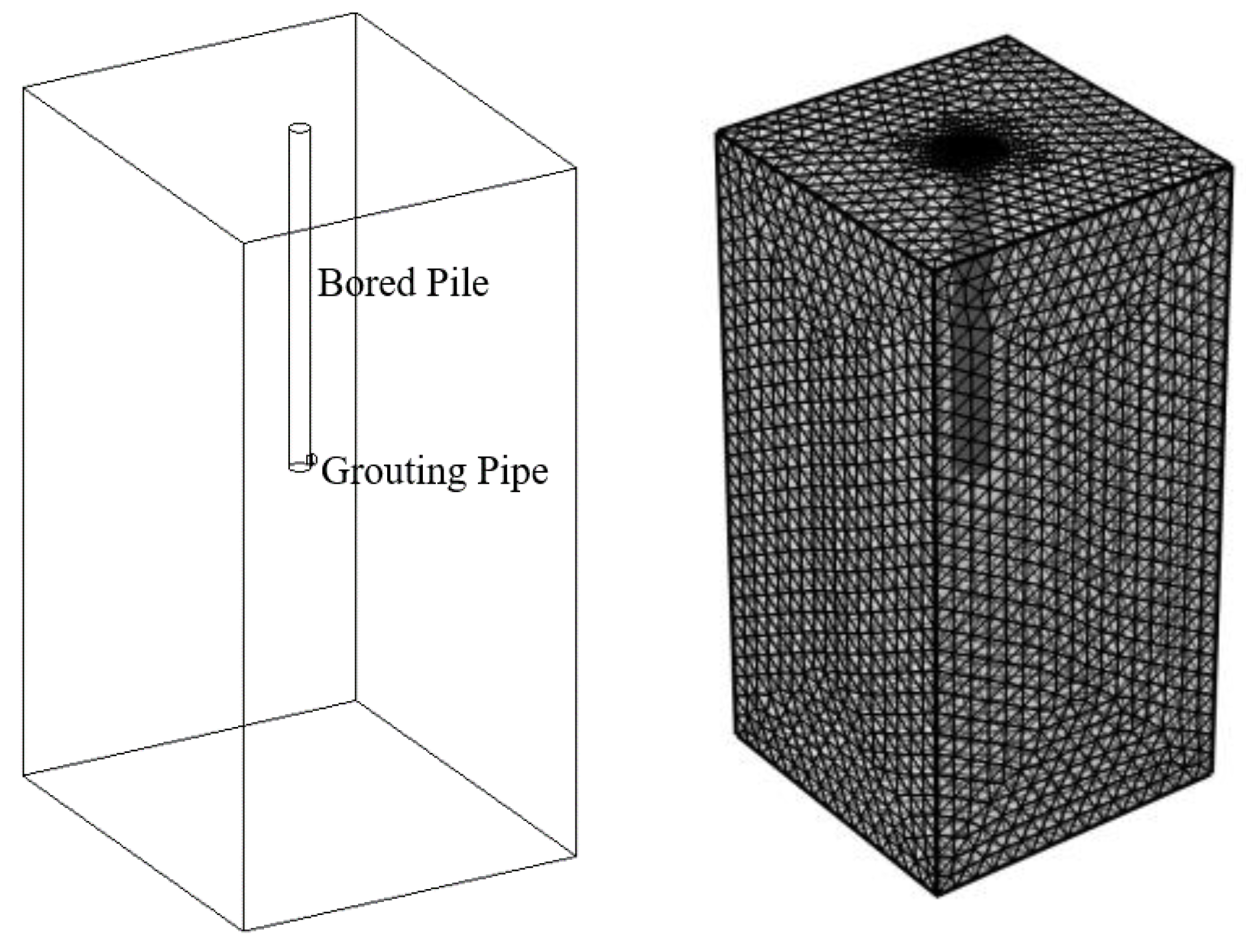
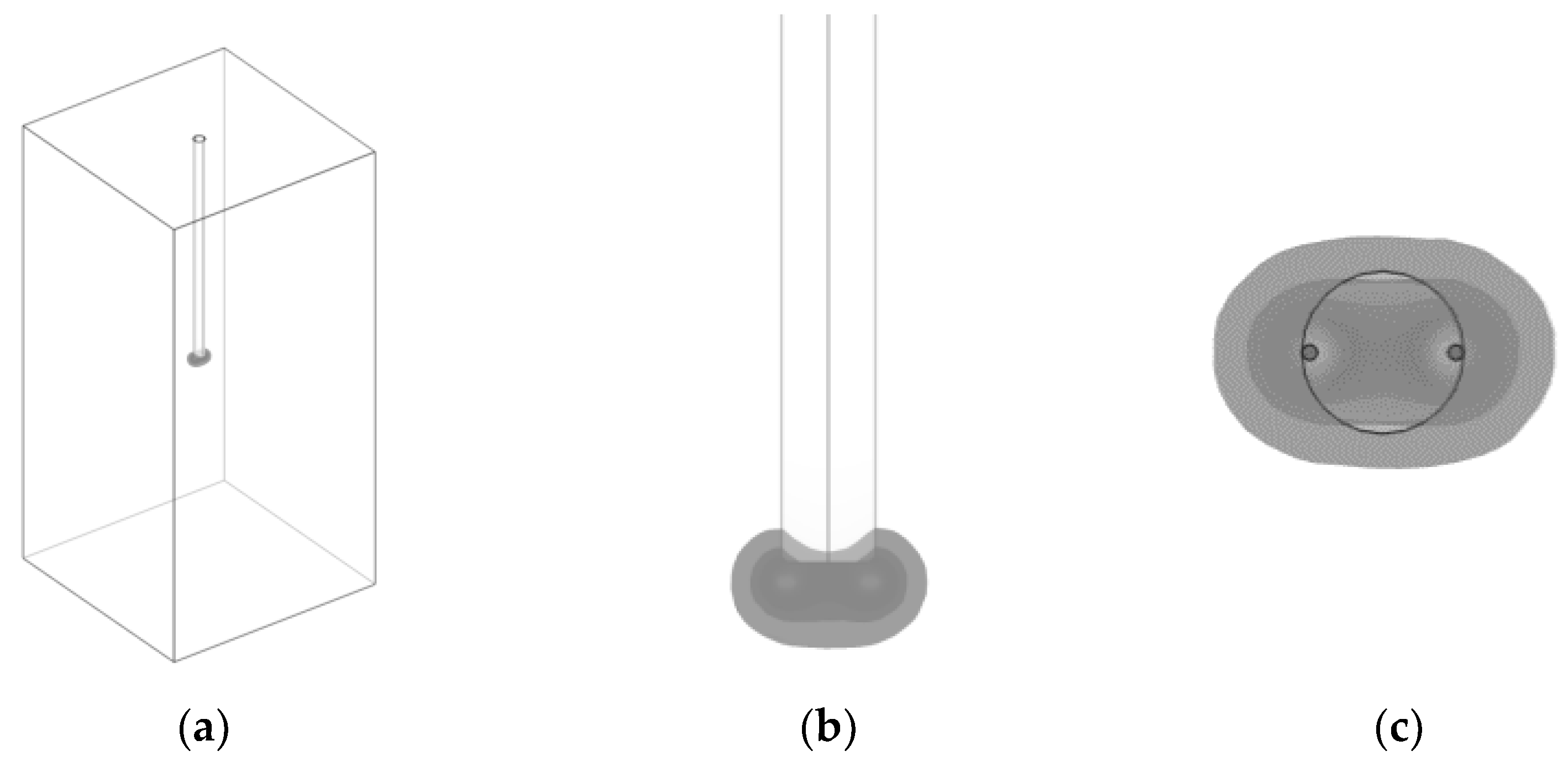

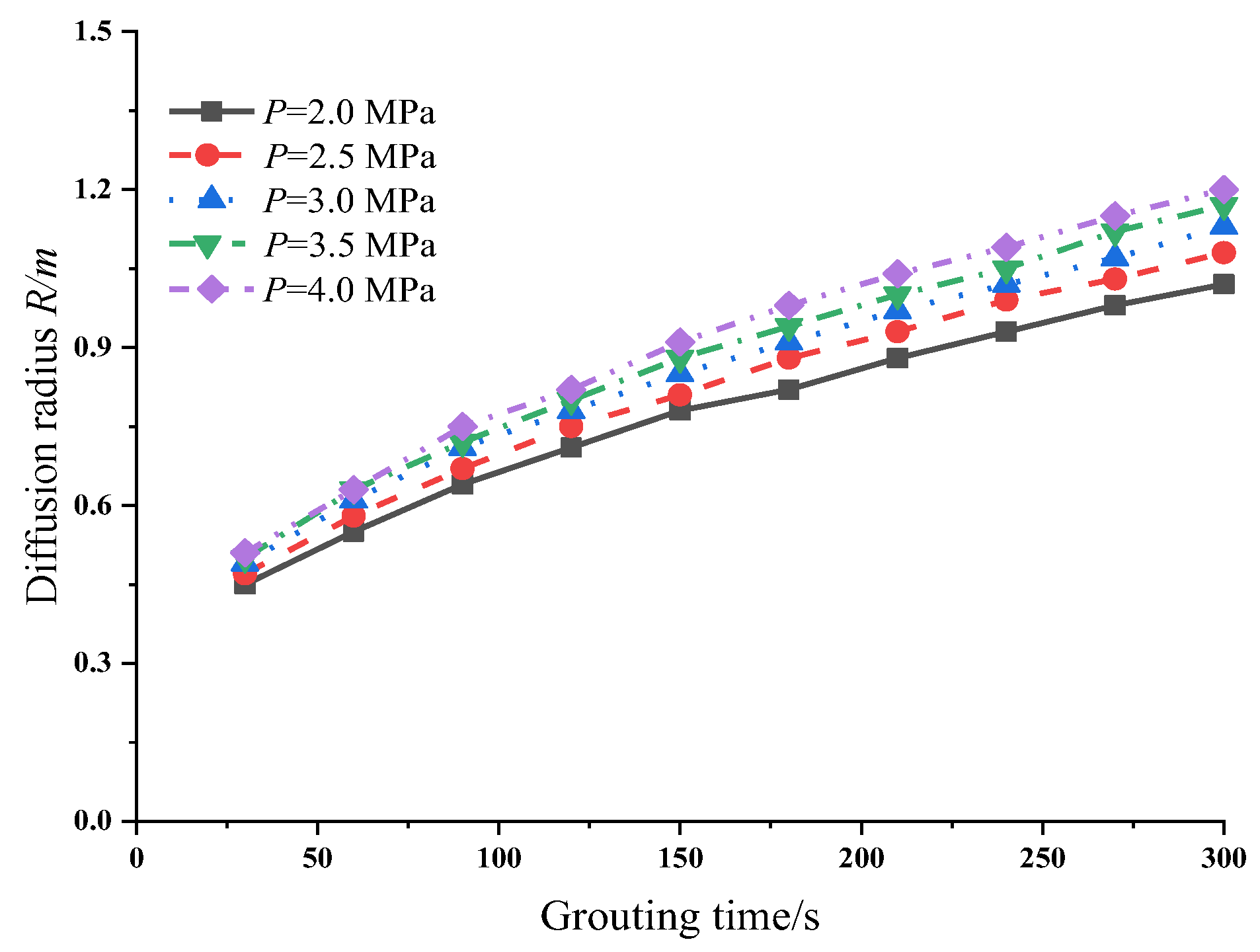
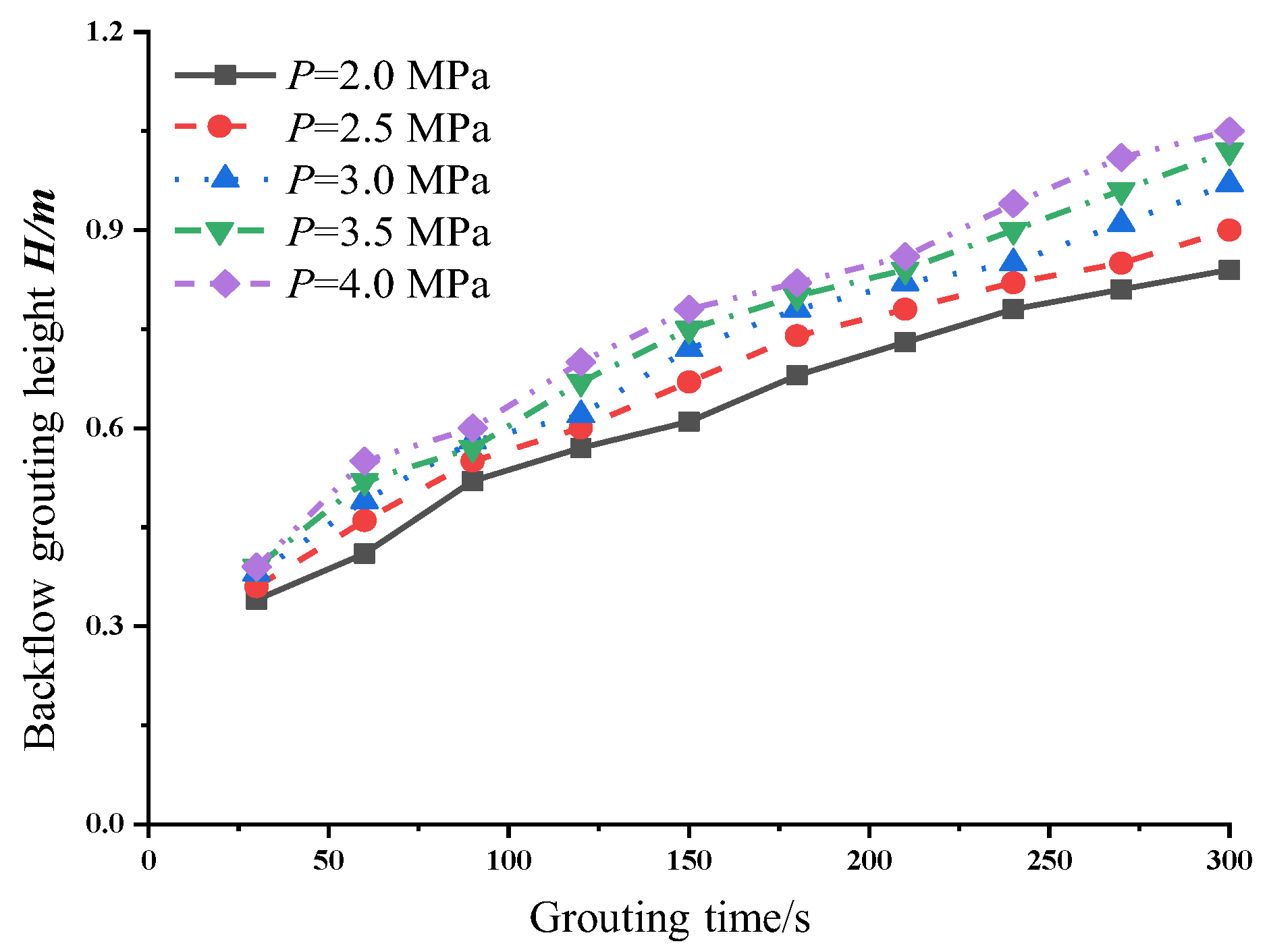
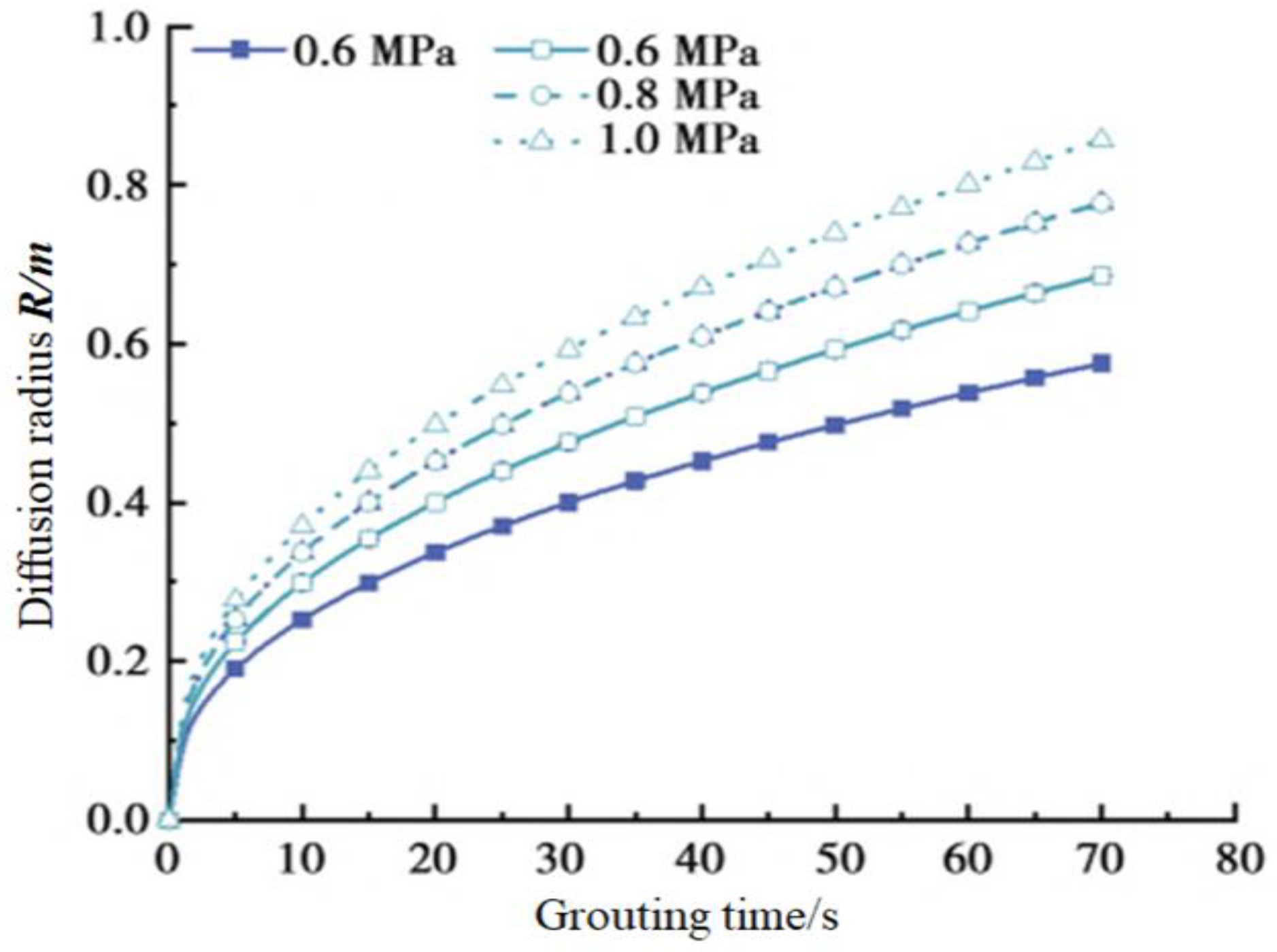
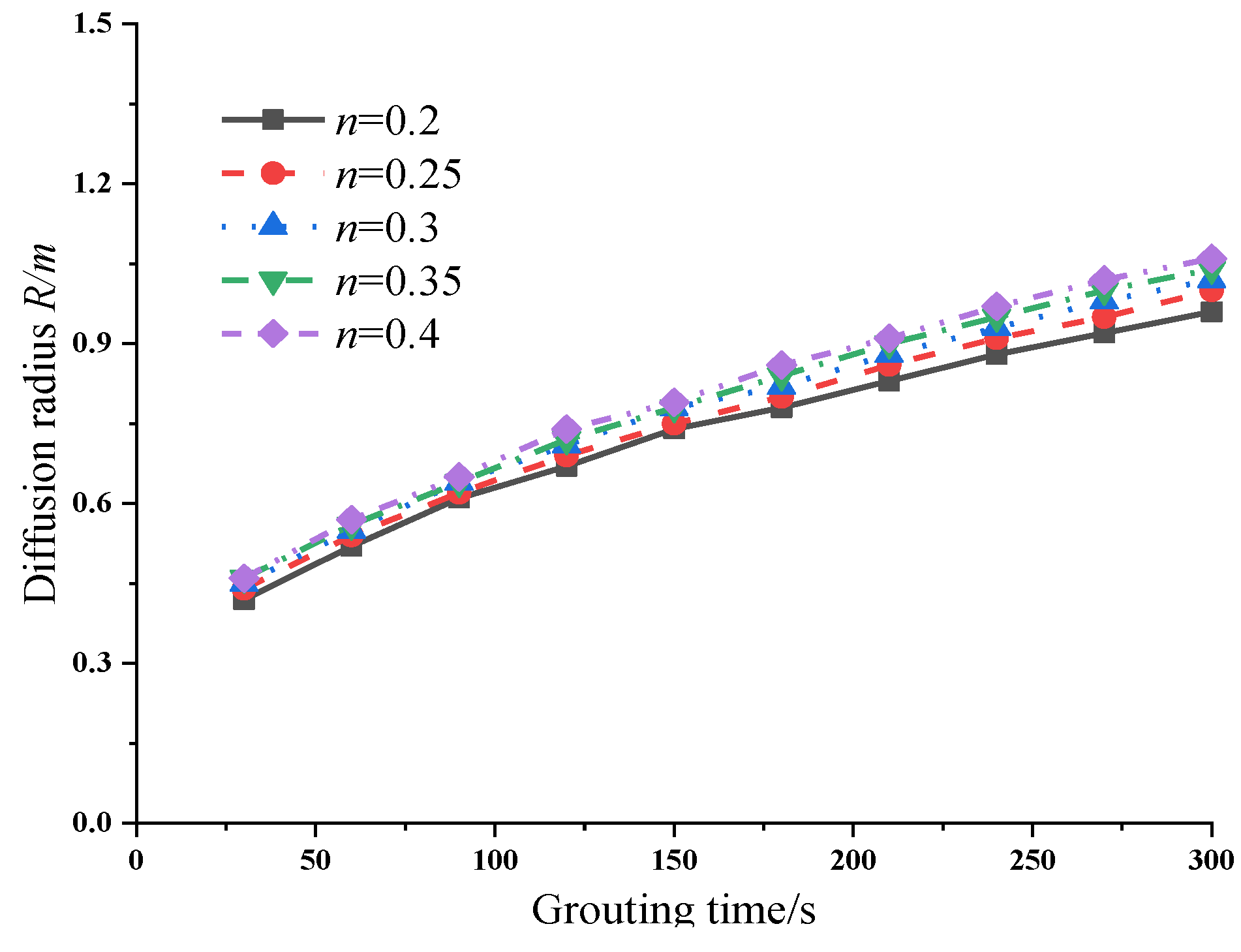
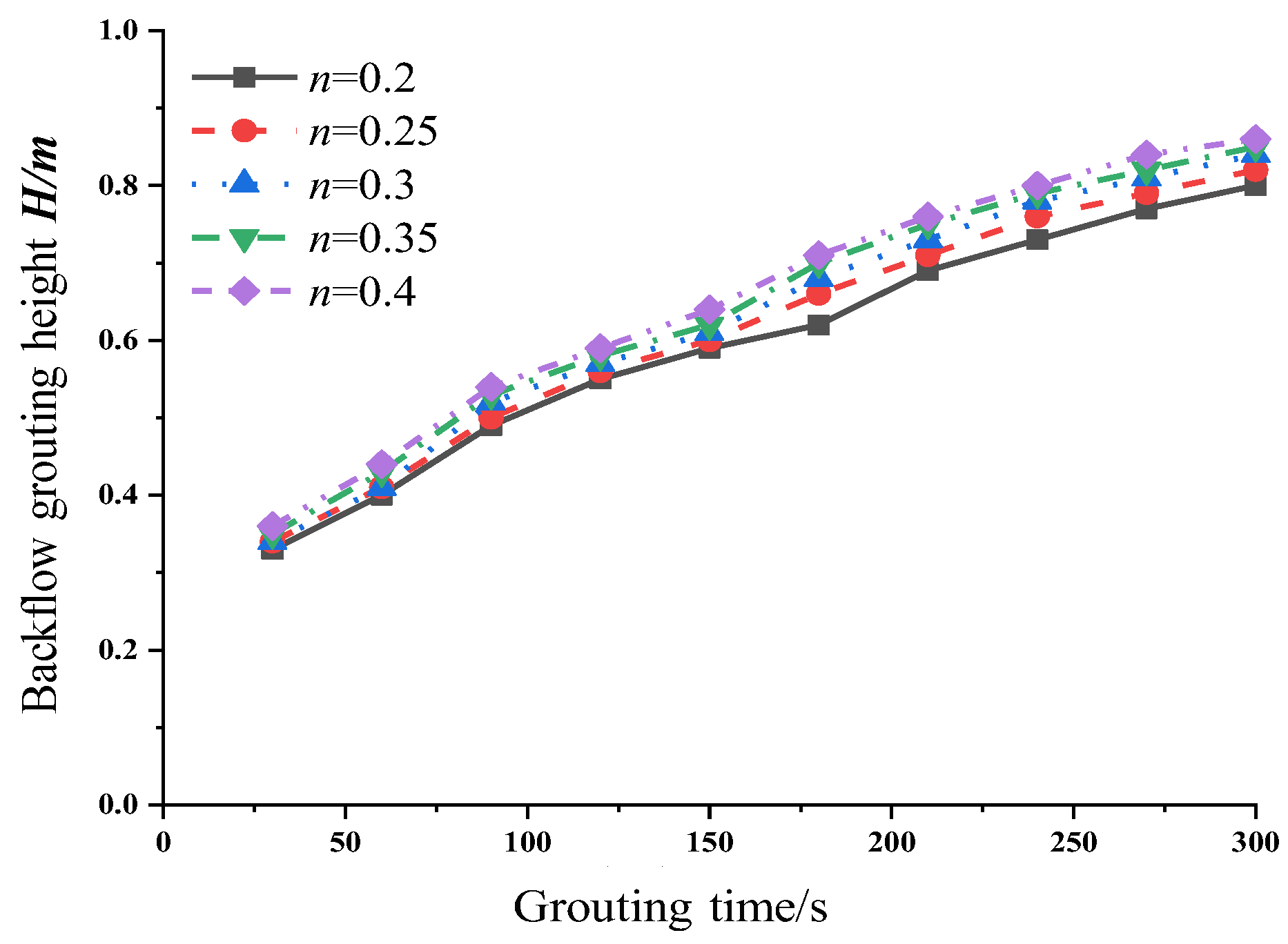

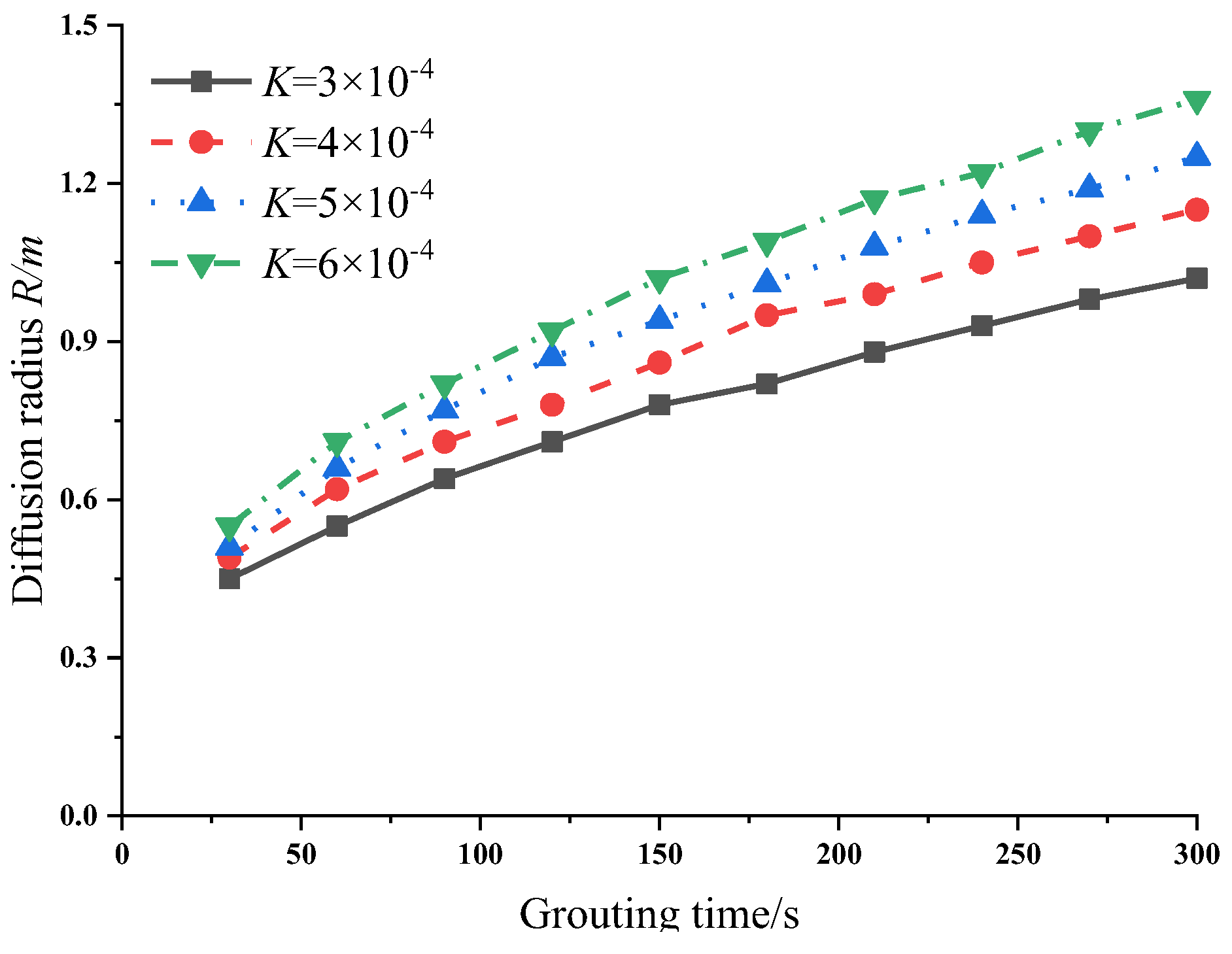
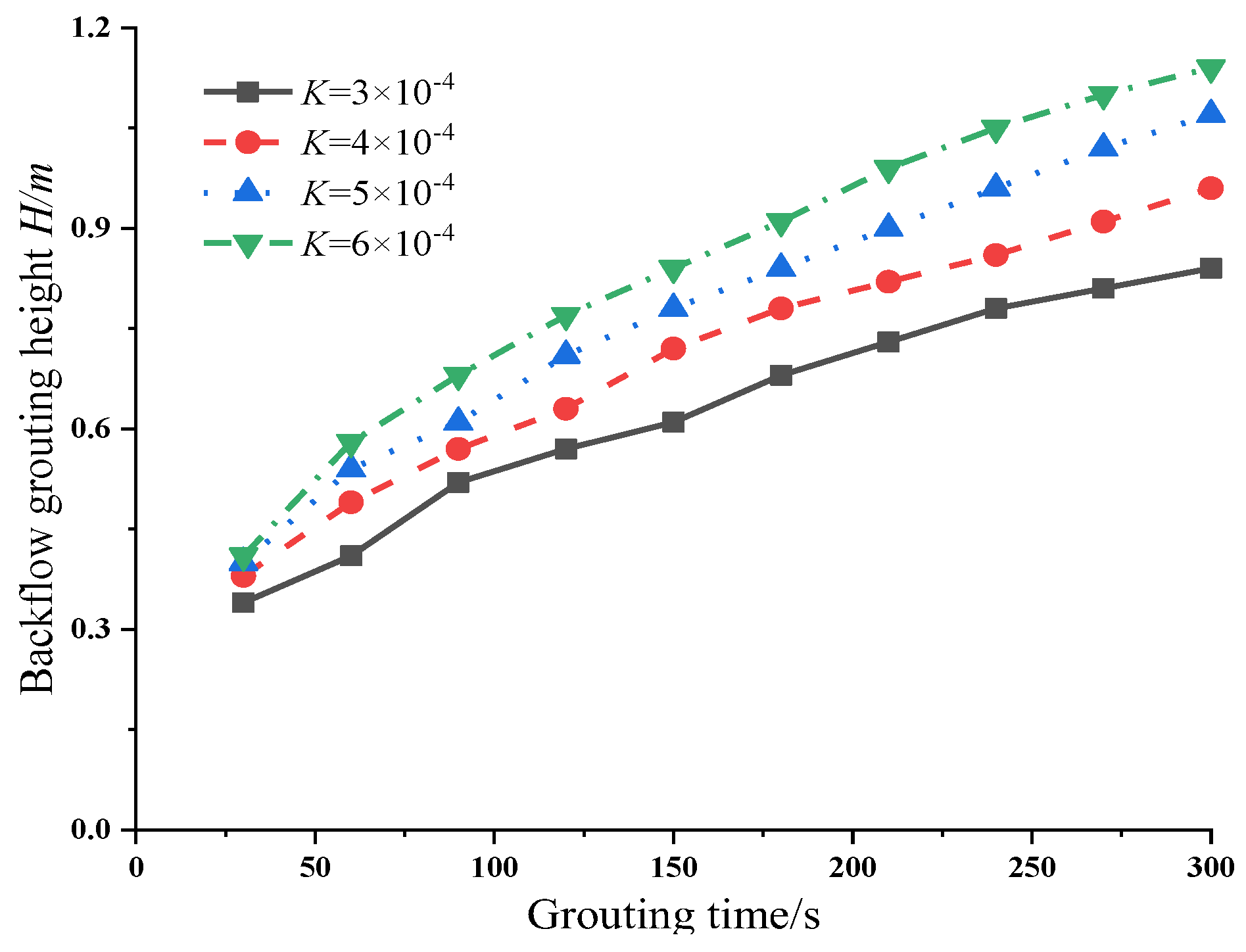
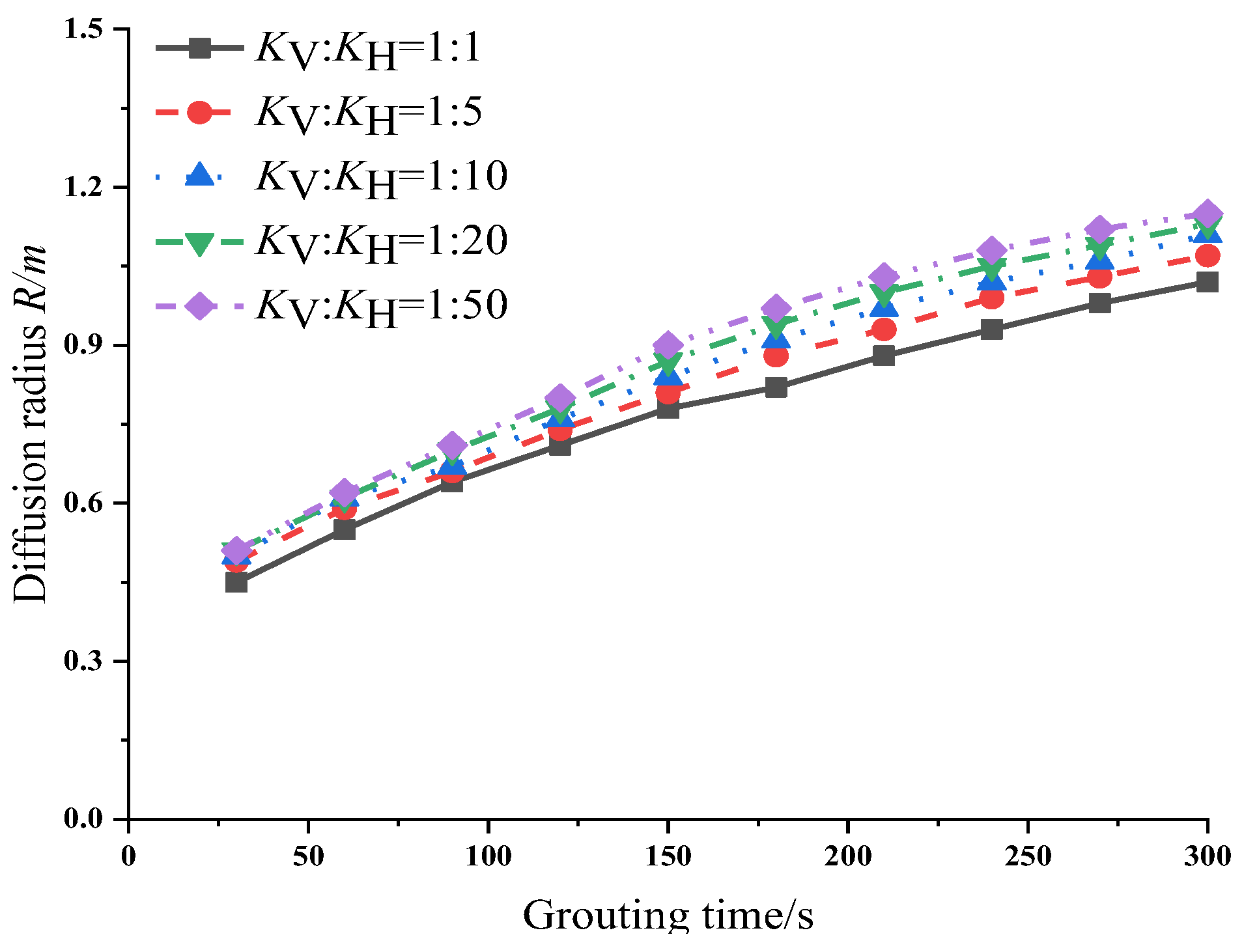
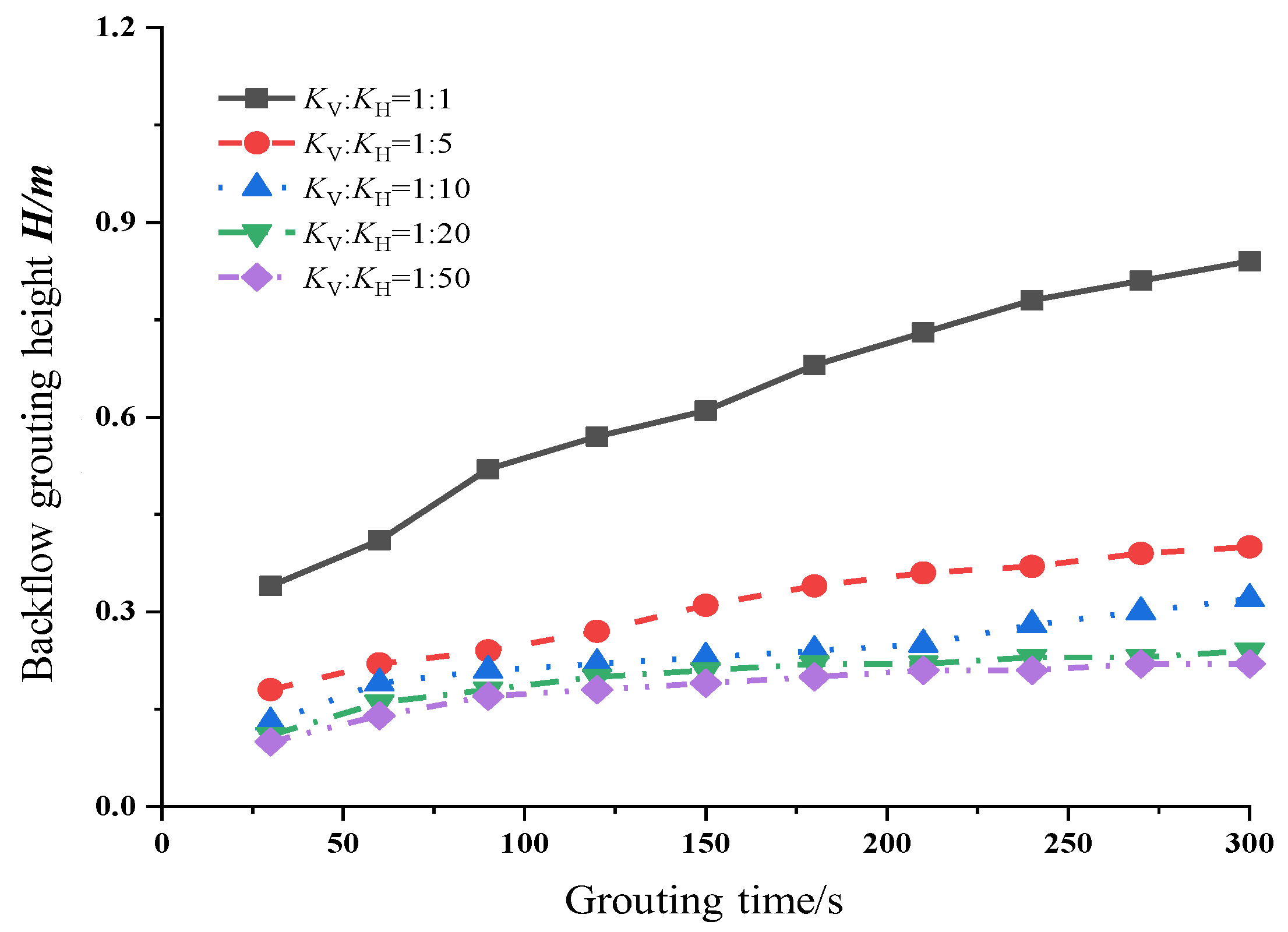
| Slurry Diffusion Coefficient k/(m·s−1) | Slurry Storage Rate Ss | Slurry Bulk Density γ/(kN/m3) | Porosity n | Grouting Pressure/MPa | Grouting Time t/s |
|---|---|---|---|---|---|
| 3 × 10−4~6 × 10−4 | 0.3 | 16.0 | 0.2~0.4 | 2.0~4.0 | 0~300 |
Disclaimer/Publisher’s Note: The statements, opinions and data contained in all publications are solely those of the individual author(s) and contributor(s) and not of MDPI and/or the editor(s). MDPI and/or the editor(s) disclaim responsibility for any injury to people or property resulting from any ideas, methods, instructions or products referred to in the content. |
© 2024 by the authors. Licensee MDPI, Basel, Switzerland. This article is an open access article distributed under the terms and conditions of the Creative Commons Attribution (CC BY) license (https://creativecommons.org/licenses/by/4.0/).
Share and Cite
Li, J.; Wu, Y.; Wu, C.; Zhu, F.; Zhao, Q.; Zhang, G.; Yan, Z.; Xu, R. Study on the Diffusion Law of Grouting Slurry at the Pile Tip of Bored Piles in Gravel Pebble Layers. Buildings 2024, 14, 2555. https://doi.org/10.3390/buildings14082555
Li J, Wu Y, Wu C, Zhu F, Zhao Q, Zhang G, Yan Z, Xu R. Study on the Diffusion Law of Grouting Slurry at the Pile Tip of Bored Piles in Gravel Pebble Layers. Buildings. 2024; 14(8):2555. https://doi.org/10.3390/buildings14082555
Chicago/Turabian StyleLi, Junhu, Yuping Wu, Chenghui Wu, Fengpan Zhu, Quanwei Zhao, Gangping Zhang, Zihai Yan, and Riqing Xu. 2024. "Study on the Diffusion Law of Grouting Slurry at the Pile Tip of Bored Piles in Gravel Pebble Layers" Buildings 14, no. 8: 2555. https://doi.org/10.3390/buildings14082555





